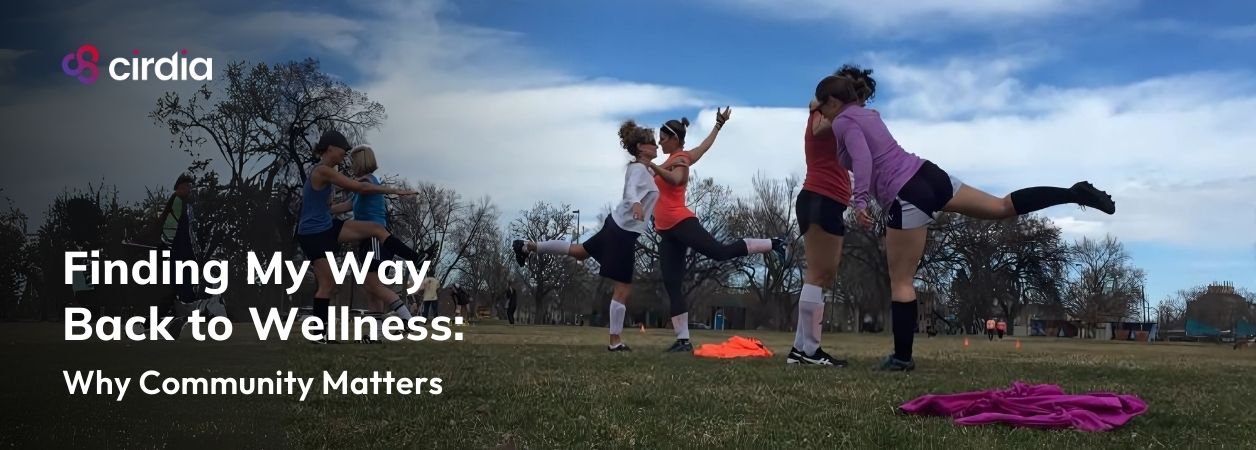Several years ago, I made a significant move away from Colorado for work. What I didn't fully appreciate at the time was how much I was leaving behind beyond just a place.
In Colorado, I had built a rich wellness community without even realizing it. I ran with a close friend on the Cherry Creek trail 2-3 times a week, and even completed a 7k race together in the city. I had created and played on a soccer team called Optimists United in a women's league in the city—a team that gathered on weekends and created both fitness and an incredible sense of community. On weekends, I often went on long bike rides, exploring the beautiful Colorado landscape. I had friends that I trained for and completed triathlons with, pushing each other to reach new goals. These connections weren't just social—they were the invisible infrastructure supporting my physical and mental well-being.
I also had a network of physical therapists and trainers I could reliably return to whenever I needed support or guidance. They knew my history, understood my body's quirks and limitations, and could provide personalized advice based on our established relationship.
When I moved, my focus shifted almost entirely to work. I love what I do, and it was easy to pour my energy into building new technologies and organizations. But gradually, I noticed changes in myself. Without my running buddy on the Cherry Creek trail, runs became less frequent. Without Optimists United, the accountability and joy of weekend soccer disappeared. Without my triathlon friends, that motivating sense of shared challenge faded. Without my weekend cycling routine, my exploration of new places diminished.
This shift wasn't just about physical activity. It was about the absence of a community that valued and supported wellness as part of a balanced life. In Colorado, well-being wasn't something I had to actively remember or prioritize—it was woven into my social fabric, reinforced by shared activities and mutual accountability.
I've tried to recreate these connections virtually. During COVID lockdowns, I worked out over Zoom with Dana—one of my best friends and now a co-founder of Cirdia. As I shared in my previous post, I also attempted to establish a virtual fitness connection with my sister-in-law. While these efforts worked to some degree for a while, they weren't the same. The technology simply didn't support the depth of connection and accountability that my in-person wellness community had provided.
A Fitness Tracker That Doesn't Sell You Out
This experience taught me something crucial: wellness is inherently social and contextual. While tracking metrics can be helpful, the most powerful motivator is often the community around us—people who share our values, notice our patterns, and care about our well-being beyond just numbers on a screen.
I don't need technology that turns my health into a game, making me chase streaks and rings instead of actually feeling better. I don't need devices designed to keep me glued to an app rather than present in my body. And I certainly don't want my fitness tracker forcing me to store my private health data in the cloud—where it can be hacked, sold, or used against me.
What I want—what many of us want—is a fitness tracker that helps me maintain my health as I age, not one that pushes me to extremes. I want gentle prompts and check-ins, not nagging nudges or goal-shaming. I want tools that respect my natural rhythms and personal choices. I want a device designed for women, by women—one that helps me stay in my body, not on my phone.
This insight profoundly shapes how we're building Cirdia. We're not just creating devices that track metrics; we're building technology that respects both individual privacy and community connection. This means:
- A system where your data lives where it belongs: with you, not on some cloud server owned by a faceless company
- Community ownership through our public benefit corporation structure and path toward a hybrid retail cooperative
- Design that recognizes different needs throughout the day and night, adapting to your real life rather than forcing you to adapt to technology
Your Body Shouldn't Be For Sale
When I look at mainstream wellness technology today, I see a missed opportunity. The focus on individual metrics and competition overlooks the profound role that supportive communities play in sustainable well-being. Meanwhile, the extractive approach to personal health information undermines the trust essential for meaningful community connection.
Your steps. Your heart rate. Your sleep patterns. Your reproductive cycle. All uploaded. All stored. All potentially for sale.
At Cirdia, we're working to reconcile these contradictions—building technology that supports both personal control of your information and community connection, both private reflection and shared experience. Because wellness isn't just about optimizing personal metrics; it's about creating the conditions for wholeness and balance in our lives.
This journey is deeply personal for me. I hope to recreate the sense of community I once had—both locally where I live now and virtually with people I care about who live elsewhere. With Cirdia, we're creating the technology I wish had existed when I moved away from my wellness community—technology that truly enables connection across distances while respecting your right to control your most personal information.
By building better tools for sharing and connection that don't force you to give up ownership of your health data, we can create new kinds of wellness communities that transcend geographic limitations. Communities where we can support each other, celebrate progress together, and hold each other accountable—all while maintaining personal control over what we share and with whom.
That's the vision driving Cirdia forward: wellness technology that brings us together rather than reducing us to data points. Technology that helps you stay in your body, not on your phone. Because tracking your health should feel empowering—not invasive.
